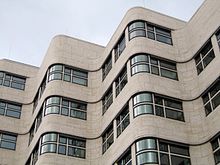Roman travertine

Roman travertine , sometimes called Travertino Romano or Romano Classico , is the trade name for a freshwater limestone . This travertine has been used for numerous structures in Rome and other Italian cities since ancient times. Today it is used in numerous countries around the world.
Surname
This type of travertine from Tivoli (formerly Tibur) and Guidonia Montecelio near Rome gave the travertine family its name, because the Latin name lapis Tiburtinus ("stone from Tibur") was mutilated to travertine over time.
There are four types of the Roman travertine, the bright Chiaro , the reminiscent of Onyx Oniciato , the dark Scuro and named after a deposit Fosse .
Origin and composition
Roman travertine originated in the Holocene .
Travertine is a limestone that has been chemically precipitated . This rock contains almost exclusively calcium carbonate and the mineral limonite gives it a yellowish to brown color. Travertines are porous and interspersed with cavities. In the process of creation, plants and parts of plants were included, which were then decomposed. The cavities often show impressions of parts of plants.
Technical characteristics and use
Roman travertine is mainly traded in two types in Germany, the light yellow and the nut-colored (called Nocce ). Both can be polished, the polishing in the open air wears off within a short period of time due to the currently prevailing acidic environmental conditions. Despite its high water absorption, Roman travertine is frost-resistant when it is sawed against the bearing.
This travertine is weakly banded. Some rock layers show almost no pores, other layers have up to 10 percent visible pores.
This stone has been used for numerous buildings, sculptures and decorative elements since ancient times. In Italy in particular, it is still used today (2008) as a building block and for door and window frames, and also for facade panels. Furthermore, it is a stone carved in demand because it is relatively soft and therefore easy to work with. Due to its frost resistance, it was and is being installed in Germany in the form of clad external stairs and external facades.
Buildings

-
Rome
- Coliseum
- St. Peter's Square (columns of the colonnades)
- Trevi Fountain
- Augustus Mausoleum
- Germany
- Foreign Office in Berlin (facade panels made of Roman travertine)
- Kö-Bogen in Düsseldorf
- Reinoldihaus in Dortmund (combination of the facade panels made of shell limestone and Roman travertine), no longer exists
- Shell house in Berlin
- Scharoun Theater Wolfsburg
- United States
- England
- New British National Library in London
See also
literature
- Monica T. Price: The sourcebook fo decorative stone. an illustrated identification guide. Thames & Hudson, London 2007, ISBN 978-0-500-51341-5 .
- Dietmar Reinsch: Natural stone studies. An introduction for civil engineers, architects, preservationists and stonemasons . Enke, Stuttgart 1991, ISBN 3-432-99461-3 .



